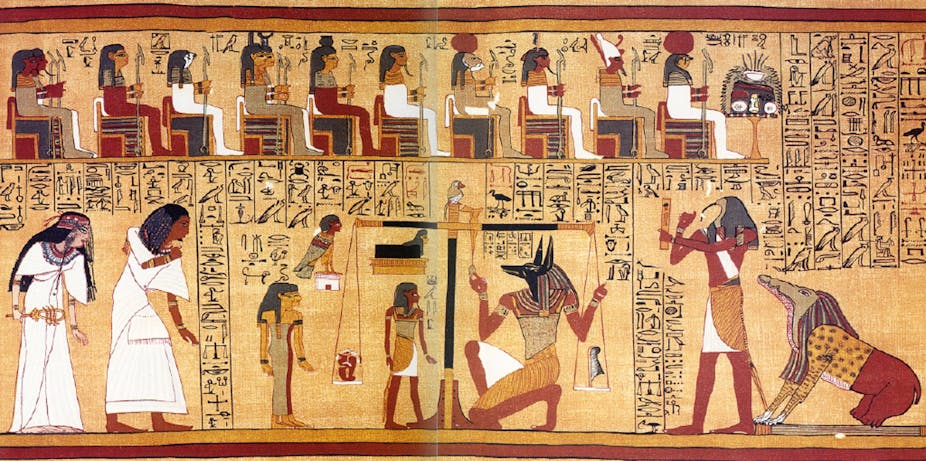The Book of the Dead describes the ancient Egyptian “weighing of the heart” ceremony as the placing of a heart on one side of a set of scales and a feather on the other.
Goddess Ma'at’s feather represents truth and justice. If the heart proves true and the life good, feather and heart will balance equally, granting access to the afterlife.
If the heart is heavier than the feather it is considered evidence of corruption. A corrupt heart is then eaten by Ammit – the “gobbler” beast.
Ancient Egyptians believed the heart to be the seat of life and a record of how it was lived. But where does the evidence of goodness live? Is it in the tissue of the heart or in some mystic area that the ancient Greeks called the soul?
This is of course the stuff of myth but without this myth, Egyptian mummification may not exist. At the heart (cough) of the matter is whether the word “evidence” can be considered as ideology, with scientific and cultural consequences.
On a set of scales, where things are weighed against each other, evidence expresses the value of proof on one side and speculation on the other.
Culture, like the ancient Egyptian gods involved in the scribing, weighing and judging of hearts, watches over and considers the balance between proof and speculation.
But culture has many gatekeepers, each with their own sets of rules and regulations. These help determine the value of proof, the nature of evidence and the judgement of experimental findings.
While the ancient Greeks pioneered the use of evidence, early Christianity used faith against it. The struggle between evidence, faith, power and money remains today – in the climate change debate, for example.
In Queensland one change of government has suddenly turned “climate change” into a dirty phrase, in spite of global evidence in its favour.
The American biologist Edward O. Wilson called science a “culture of illuminations”. Science, he says, has given us “the most powerful way of knowing about the world ever devised”.
But this illumination takes place in a world of politics. Politics, argued playwright Harold Pinter, prefers people to “remain in ignorance”. To “live in ignorance of the truth, even the truth of their own lives” politics has to maintain power and control.
Whether evidence can trump expediency in the struggle between a “science that serves agendas” and a “science that reveals knowledge” depends on the society.
“Proof” – already a tricky construct – tends to translate in our society as “knowledge based on current understanding”, a definition that gives scepticism and faith an upper hand. A raised eyebrow can usurp an elegant formula in the hands of a media hungry for conflict and opposing points of view.
Science uses evidence against faith, but it can never win this kind of conflict because the paradigms are not equal. Religion and politics are a bit like Ma’ats feather. They represent the moral politics of society against which science is perpetually weighed.
That the moral politics do not necessarily represent majority views is mostly irrelevant. Rhetoric cannot be weighed and rhetoric is the system through which scientific evidence is often resisted.
Peer review, reproducibility and objectivity are often referred to as the touchstones of science. But hindsight is the ghost of science, haunting science and scientists with its past mistakes. The Japanese earthquakes and tsunami in 2011 retrospectively revealed the folly of building nuclear reactors near fault lines.
It is perhaps this hindsight that complicates the relationship between science, evidence and culture more than anything else. History reveals flaws in studies, corruption in processes, loss of ecologies and socially-confronting practices, such as animal testing and genetic modification.
As a result, many people have become suspicious of the word “evidence” – and perhaps rightly so. After all, evidence is a product of human endeavour and as such is fallible.
Seeking evaluation and certainty are not just laboratory endeavours; they are political and community ones as well. Such complexity can lead to unpredictable side-effects and devastating mistakes, such as Australia’s cane toad problem.
Evidence is crucial to conviction and advancement in law and science, yet wrongful convictions happen, meaning today’s proof can be tomorrow’s lawsuit.
Scientific results can be manipulated to serve agendas that ultimately undermine an experiment’s intrinsic value. Evidence, as a construct, resists the cultural rhetoric of politics, economics, ambition and fashion but it’s also inscribed by these forces – it is rarely as neutral or independent as we might like.
Sometimes it’s the covering-up of evidence, the destruction or the suppression of “truth”, that interferes with smart decision making; sometimes there might be a temptation by politicians and economists to ignore evidence in favour of maintaining a healthy “bottom line”.
In technology, agriculture, medicine and engineering, scientific evidence and processes have brought us astonishing advances in health and quality of life. A side-effect of this, however, is the impact these advances have had on the Earth’s environment and its human, and non-human, inhabitants.
When these results are weighed against each other, a great deal clearly hangs in the balance. Evidence has a big role to play in deciding which way the scales will tilt.

